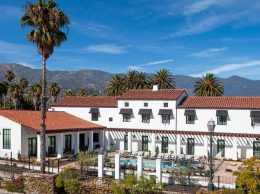UCSB experts see an industrial revolution for the seas
IN THIS ARTICLE
- Latest news Topic
- Marissa Nall Author
By Marissa Nall Tuesday, October 20th, 2020
UC Santa Barbara researchers are gearing up for a second industrial revolution, this time in the world’s oceans.
The period of rapid change that began on land in the 1700s “is really just beginning now in the oceans, the other 70 percent of our planet,” Douglas McCauley, Director of the Benioff Ocean Initiative at UCSB, said during an Oct. 7 virtual forum hosted by the Santa Barbara nonprofit Sustainable Change Alliance.
The industrialization of the oceans puts a premium on new metrics akin to a GDP for the ocean, and on ways to protect ocean ecosystems. Enter the Ocean Health Index, developed by the National Center for Ecological Analysis and Synthesis, to measure things like tourism, job creation, fishing output and biodiversity.
“If we were to treat the oceans as a state when doing our accounting, we would find an immense amount of economic value,” McCauley said.
Beyond the ocean’s global role in oxygen production and as a source of food, ocean-related tourism amounts to some $390 billion annually, he said, much of which directly funds development goals in less wealthy communities.
“They’re a pillar in our global economy and would rank about the seventhlargest economy in the world,” he said.
These coastal communities also have great aesthetic, historic and cultural value, he added.
“These are all really important attributes of ocean health, and if we aren’t measuring these things, we can’t know if or how well we’re achieving these outcomes,” said Ben Halpern, NCEAS director and professor of marine ecology and conservation planning at UCSB.
The host of the forum, Sustainable Change Alliance, promotes impact investing on the Central Coast, a type of investment that seeks social and environmental goals in addition to a financial return.
The new industrial boom could present opportunities for impact investment, the panelists said, ranging from large-scale aquaculture projects to “blue bonds” that finance the development of sustainable marine ventures.
The acceleration of human industry in the ocean also offers researchers and policymakers opportunities to realign incentives for businesses that make their living from it. Many of the strategies have already been deployed to encourage long-term, sustainable profit and minimize resource depletion, said Christopher Costello, professor of resource economics at UCSB and director of the university’s Environmental Market Solutions Lab, or emLab.
“The ocean is an especially worthy candidate for impact investing … partly because it’s this enormous trove of ecosystem services,” Costello said.
But the tools that work for investing on land—for instance, property easements used to conserve or encourage sustainable development of key environmental areas—often don’t translate to ocean ecosystems.
“There typically aren’t property rights, there aren’t prices and markets for the kinds of services” the ocean provides, Costello said. “We’re going to have to be clever about finding the right ways to invest.”
In this industrial revolution, researchers and businesses have data and technology at their disposal to guide it as it unfolds, McCauley said.
Panelists highlighted innovations that can shed light on overfishing, human rights violations and encroachment into marine reserves that would otherwise generate market failures. Other private sector systems have been deployed to track the booming ocean shipping and logistics industry, help ships avoid whales and capture plastic before it reaches the sea.
“It’s our second rodeo, if you will, with industrial revolutions, and I think we all intend to get this one right,” McCauley said. “We got the memo that some of that change creates a disproportionate amount of burden for the most vulnerable people, especially that environmental change, and we don’t want to recreate that kind of environmental injustice.”
Support from policymakers will also factor heavily into things like carbon pricing, improved fisheries management and waste recycling, Costello said.
The panel took place the same day Gov. Gavin Newsom signed an executive order that set a new goal for ocean conservation. The order launched a new California Biodiversity Collaborative with a mandate to chart a course to 30 percent of the state’s coastline and waters conserved by the year 2030, using strategies to enhance biodiversity, food security, and mitigate climate events, among other outcomes.
At UCSB, the launch of a new Ocean Innovation program through the campus’s Center for Ocean Advancement in Science and Technology, or COAST, aims to bring entrepreneurship to the same equation, said Steve Gaines, dean of the Bren School of Environmental Science and Management. New advancements will focus on big data analytics and market-based approaches “to accelerate prudent investments,” in ocean resources, he said.
NOTE: An earlier version of this story included an incorrect name for the Center for Ocean Advancement in Science and Technology, or COAST.












